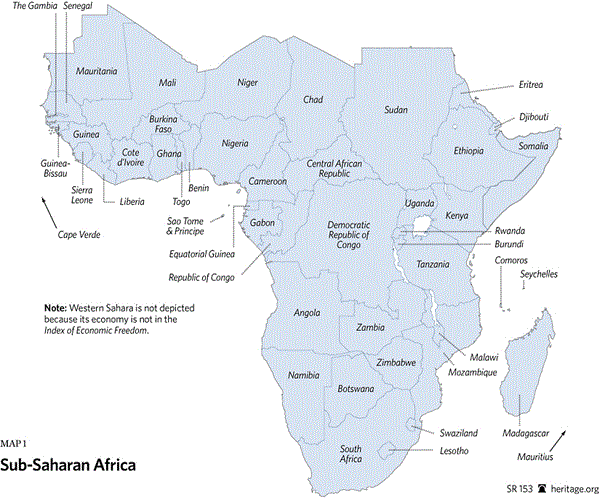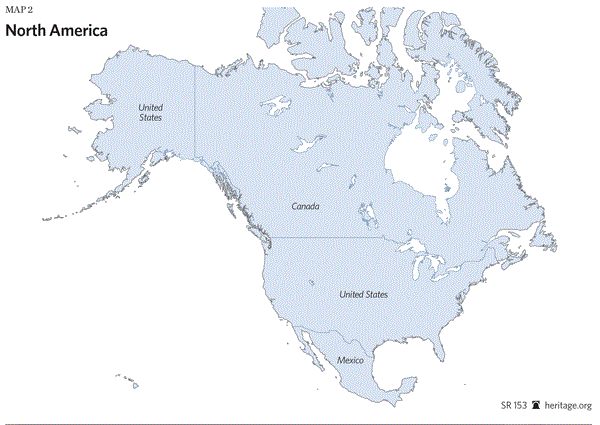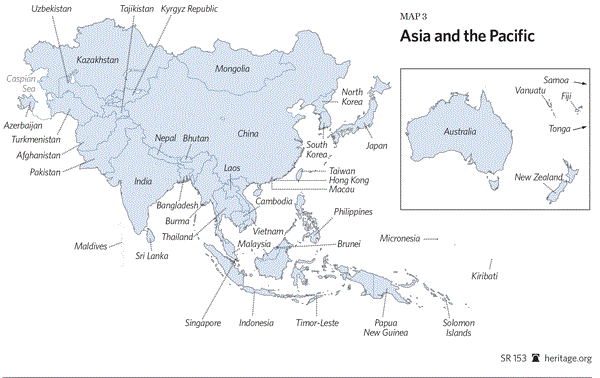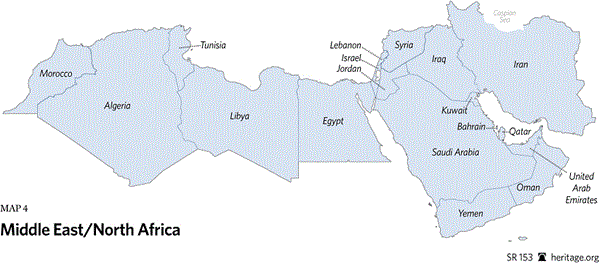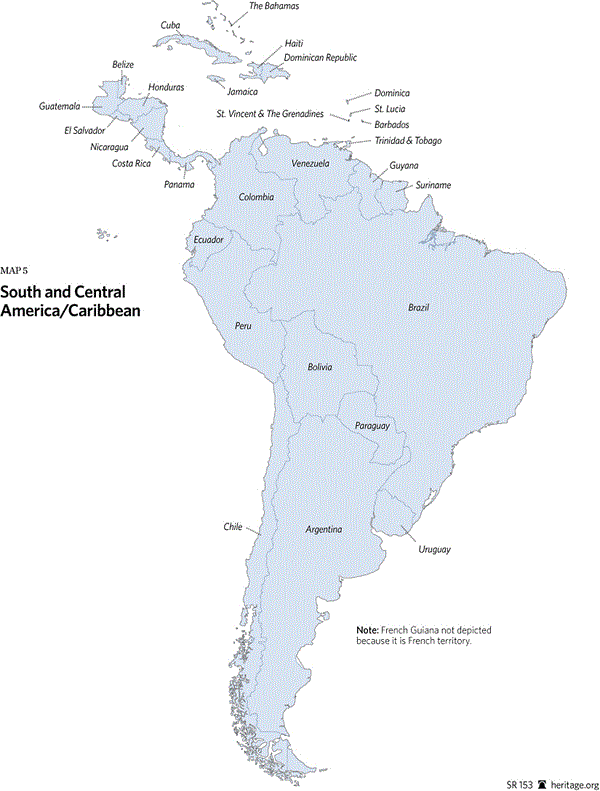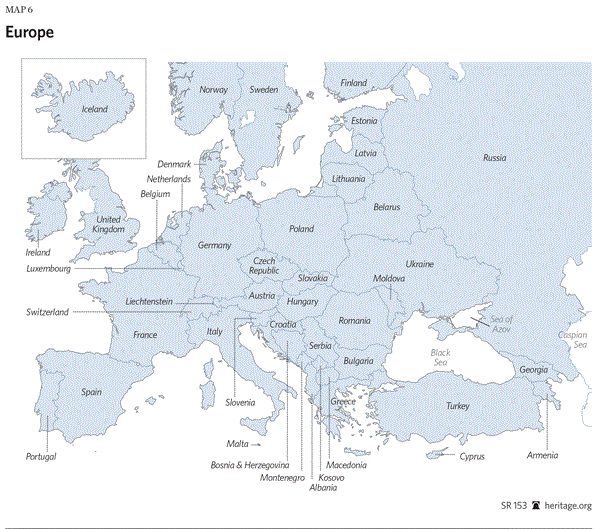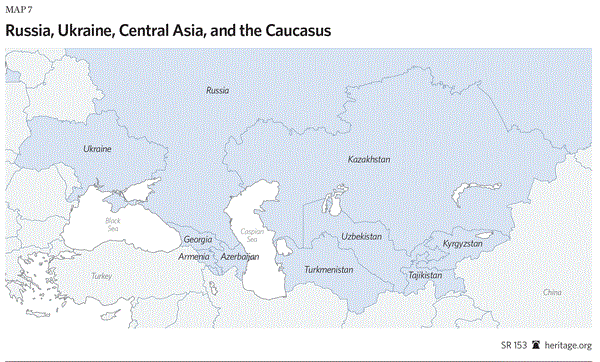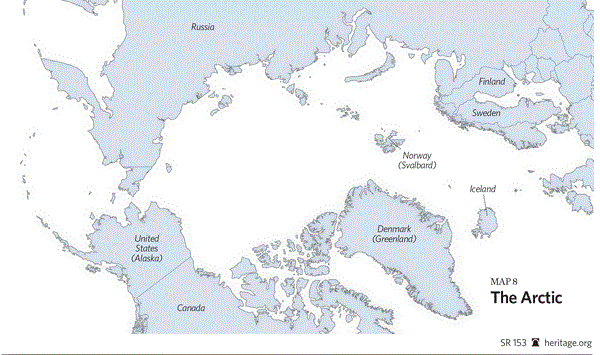Contributors
Luke Coffey is Margaret Thatcher Fellow in the Margaret Thatcher Center for Freedom at The Heritage Foundation. Ariel Cohen, PhD, is Senior Research Fellow in Russian and Eurasian Studies and International Energy Policy in the Douglas and Sarah Allison Center for Foreign and National Security Policy at The Heritage Foundation. Charlotte M. Florance is a Research Associate for Economic Freedom in Africa and the Middle East in the Allison Center. Anthony Kim is Senior Policy Analyst in the Center for International Trade and Economics (CITE) at The Heritage Foundation. Ambassador Terry Miller is Director of CITE and Mark A. Kolokotrones Fellow in Economic Freedom. Ryan Olson is a Research Assistant in CITE. James Phillips is Senior Research Fellow for Middle Eastern Affairs in the Allison Center. Ana Quintana is a Research Associate for Latin America in the Allison Center. Bryan Riley is Jay Van Andel Senior Analyst in Trade Policy in CITE. James M. Roberts is Research Fellow for Economic Freedom and Growth in CITE. William T. Wilson, PhD, is a Senior Research Fellow in the Asian Studies Center at The Heritage Foundation. Stanislav Miachkov with The Heritage Foundation’s Young Leaders Program provided valuable research assistance.
Edited by James M. Roberts.
In a world beset with political crisis, economic stagnation and turmoil on every continent, the United States in recent years has stepped back from its traditional role as leader of the free world, opting to “reset” its relationships with potential adversaries and reduce or withhold its active engagement in the worldwide struggle for liberty. By contrast, at home, the U.S. government is intruding ever more forcefully into the lives of citizens, building a regulatory state that threatens economic freedom and growth.
In fact, the U.S. is the only country in the world in 2014 to have registered lower scores in the Index of Economic Freedom, published annually by The Heritage Foundation and The Wall Street Journal, for seven years in a row. Americans have now suffered reductions in their economic opportunities every year since 2008. Even more worryingly, as of 2014, the U.S.—which has long since departed from the top rank of “free” countries and is now only “mostly free”—has dropped out of the world’s top 10 most economically free altogether.
This reduction in freedom has been accompanied by stagnant growth of the U.S. economy and persistently high unemployment and underemployment. Promoting adoption of the revitalizing policies of economic freedom in the United States is essential to creating good new jobs for Americans. It is also vital to promote economic freedom abroad, since U.S. companies and workers increasingly rely on international trade and finance to improve productivity and build markets. America is a global economic superpower, but to remain so, its government and business community must encourage the free flows of capital, goods, services, and ideas around the world, which contribute to ongoing U.S. and global prosperity. Implementation of such forward-looking policies will kick-start the economic dynamism and innovation that will lead to better products, new markets, and greater investment.
In this third annual Special Report, The Heritage Foundation Economic Freedom Task Force—a diverse team of policy experts—makes key observations about eight global regions: (1) sub-Saharan Africa; (2) North America (the U.S., Canada, and Mexico); (3) Asia–Pacific; (4) the Middle East and North Africa; (5) Central and South America and the Caribbean; (6) Europe; (7) Russia, Ukraine, Central Asia, and the Caucasus; and (8) for the first time, the Arctic. In each region, the task force identifies obstacles to expanding economic freedom, policies that regional governments should implement, and 27 concrete recommendations for U.S. actions to help promote economic liberty.
While these recommendations are crafted for individual regions, some themes appear repeatedly worldwide—particularly the importance of protecting property rights, fighting corruption, and pushing back against a revival of the failed state-owned-enterprise model and creeping crony corporatism. These are summarized in the introductory “Global Issues” section.
To help nations achieve such goals, the task force also identifies opportunities in virtually every region in which the United States government can forge new agreements and initiatives that will promote job-creating, private sector–led trade and investment. The emphasis on free trade is not surprising. Countries with the lowest trade barriers also have the strongest economies, the lowest poverty rates, and the highest average levels of per capita income. Thus, the “free trade tool” is an ideal instrument for expanding economic freedom. In particular, new initiatives, such as the ongoing negotiations for a Trans-Pacific Partnership (TPP) among as many as 14 Pacific Rim nations, as well as a Trans-Atlantic Trade and Investment Partnership (TTIP) between the European Union (EU) and the United States, hold some promise. These agreements, if negotiated well, could create new economic opportunities by expanding trade among the United States, Asia, Latin America, and the member states of the European Union.
The increasingly dire warnings of the 2014 Index of Economic Freedom about the accelerating loss of economic freedom in the U.S. are too stark to ignore. Only by pressing for more freedom at home and abroad can the U.S. hope to avoid decline. A plan to put the United States back on the path to more economic freedom is laid out in The Heritage Foundation’s Saving the American Dream plan. A plan for promoting economic freedom in the world is laid out in this Special Report. It offers Washington a blueprint—a global agenda—for a practical and effective strategy to promote economic freedom around the world and restart growth at home. This global agenda can—and should—be implemented now.
2014 Economic Freedom Agenda: Global Issues
A World with More Trade and Investment Freedom. International trade plays an increasingly significant role in the economies of the United States and other countries. Thanks to U.S. leadership in the Uruguay Round trade talks, 123 countries collectively implemented the largest global tax cut in history and created the World Trade Organization (WTO) in 1995 to mediate trade disputes. Trade disagreements that could have escalated into trade wars in the past are now moderated by impartial referees.
With first the U.S.–Canada free trade agreement (FTA) in the 1980s, and then the North American Free Trade Agreement (NAFTA) in the 1990s, the United States initiated a healthy global contest to see which country could sign the most free trade agreements. (So far, Chile is in the lead, having inked agreements with 56 countries; Mexico is second with 44 countries.) Overall, hundreds of bilateral and regional trade agreements are in force today among free-market countries, and many more are being negotiated.
Lack of leadership by the Obama Administration, however, has allowed negotiations for further global trade liberalization through the Doha Round (the successor to Uruguay) to grind to a halt. Furthermore, the long delays during the first Obama Administration in implementing the FTAs with Colombia, Panama, and South Korea severely hampered momentum for trade liberalization in the United States.
There are some potential bright spots for global trade freedom: the ongoing TPP talks among Australia, Brunei, Canada, Chile, Japan, Malaysia, Mexico, New Zealand, Peru, Singapore, the United States, and Vietnam (and possibly Taiwan and South Korea). The goal of the participants is to make the TPP a “21st century” or “gold standard” trade agreement. To reach this goal, each country must be willing to make beneficial policy changes that will include reductions in tariff and non-tariff barriers, improved protection of legitimate rights with respect to intellectual property and international investment, dismantling agricultural and many other government subsidies, and limiting support of state-owned enterprises (SOEs). The resulting agreement should include a mechanism to facilitate easy accession by other countries in the future.
Unfortunately, TPP negotiations to date have included excessive U.S. posturing on environmental standards and labor regulations. Although there is a danger of further such posturing in negotiations that began in 2013 on a Trans-Atlantic Trade and Investment Partnership between the European Union and the United States, the potential benefits to the U.S. and Europe make the TTIP worth pursuing.
Meanwhile, American trading partners, such as Canada and Chile, have forged ahead with new agreements, leaving the U.S. behind. In the regional sections below, Heritage Foundation experts lay out specifics on how the United States can catch up around the world. The United States should encourage other countries’ efforts to reduce trade barriers, including African countries’ proposed Continental Free Trade Area (CFTA) to boost Africa’s intra-regional trade and the Alliance of the Pacific (Chile, Colombia, Mexico, and Peru—possibly to be joined in 2014 by Costa Rica and Panama).
U.S. programs, such as the U.S. Generalized System of Preferences (GSP) and the African Growth and Opportunity Act, promote mutually beneficial trade and growth. These programs should be expanded to include more categories of imports and extended on a long-term basis. Foot-dragging on trade by the Obama Administration has had a larger cost: the decline of the credibility of the U.S. as an economic model. It was not long ago that people around the world spoke of the “Washington consensus,” by which they meant a generally free-market policy mix. Now foreign governments deride America’s slow growth and policy failures. Chinese leaders in particular look with disdain on American policy advice, notwithstanding their own rapidly mounting problems and their pressing need for another wave of economic reforms.
As documented in the 2014 Index of Economic Freedom, protectionist measures, industry-specific subsidies, and excessive (and potentially protectionist) “enforcement” actions, such as anti-dumping and countervailing-duty regulatory measures, reduce efficiency and competitiveness and diminish the prosperity of all nations. These counterproductive policies should be resisted by all countries, and the U.S. should take the lead.
In an economically free country, there are no constraints on the flow of investment capital. Individuals and firms are allowed to move their resources to and from specific activities, both internally and across the country’s borders, without restriction.
Regarding investment, then, the U.S. government should refocus its development policy on trade and investment and vigorously pursue an expanded commercial agenda that makes investment in developing countries more attractive to the investor—for instance, by establishing a broader network of bilateral investment treaties (BITs) or trade and investment framework agreements (TIFAs) and negotiating double-taxation treaties that remove fiscal burdens from investment-oriented capital flows.
A World with More Freedom for Workers. Labor freedom and business freedom indicators in the 2014 Index of Economic Freedom reward countries with laws, regulations, and policies that give workers and employers flexibility and opportunity. In addition, guest-worker visa programs can help countries meet growing needs for skilled technology workers or seasonal workers. These guest-worker visas can also address politically difficult immigration issues.
In the United States, H1-B visas for high-tech workers help American high-tech companies recruit skilled immigrants, such as engineers and computer programmers. Under current law, the government can issue only 85,000 H1-B visas each year—65,000 to highly skilled private-sector workers and 20,000 to those with advanced graduate degrees from U.S. universities. But demand for such skills is much greater—the caps are reached very quickly every year.
Another pro-economic freedom measure is making it easier for business people to travel between countries. In the United States, expanding the Visa Waiver Program (VWP), particularly by adding member countries in Europe and Latin America, would further reduce transaction costs and increase efficiency for American businesses. Chile has now been invited to join the VWP, but America’s great ally and trading partner Poland continues to languish without the VWP that it richly deserves.
The VWP has also boosted U.S. tourism receipts, since most tourist and business travel to the United States originates in countries enrolled in the Visa Waiver Program, and it is therefore an important instrument to promote economic exchange with like-minded nations. The Obama Administration should speedily approve many more eligible and deserving nations for the VWP.
A World with Less Corruption and More Property Rights. Economists from Adam Smith to Milton Friedman have noted the crucial role of property rights as an engine of economic growth, on which the equally important development of a middle class depends. Establishing those property rights is step one for economic freedom.
For nearly every country on the globe, the Index of Economic Freedom’s “freedom from corruption” score is nearly always the lowest of the 10 indicators measured. Corruption is a perennial and difficult problem to address throughout the world, yet it must be addressed constantly by governments through unceasing efforts and vigilance if they hope to create conditions favorable to economic growth and prosperity. The degree of corruption in a country is a good barometer of the strength of its judicial institutions and rule of law, both of which are tied strongly to how effectively a country protects private property.
Many countries’ economic freedom scores would be substantially higher were it not for the prevalence of government corruption. The solution, however, does not lie in passing more anti-corruption laws, which are ignored in practice. In fact, too much regulation can reduce respect for the law and frequently reduces transparency by causing confusion. This creates an environment for predatory behavior by the government or its favored cronies and thereby worsens corruption.
The best means of fighting corruption is transparency. Laws should be clear, logical, and simple to understand. Rather than creating additional statutes, governments should inform their publics about the laws that already exist.
Lack of reliable property rights is a problem worldwide. The starting point for development, especially in lower-income countries, is greater agricultural productivity, which stems first and foremost from secure property rights to land. These rights are absent in much of the world.
The single biggest problem in the Indian economy, for example, affecting hundreds of millions of people, is uncertainty about land ownership. Most resources associated with land belong to the state, and many attempted land sales conflict with contested ownership and require corrupt and horribly inefficient government involvement to carry out. This system undermines agricultural productivity and obstructs progress in alleviating poverty.
In dealing with developing economies, the U.S. needs to expand from focusing almost exclusively on intellectual property rights (IPR) to include land and other property rights. While in the developed world the information and IPR sectors are vitally important parts of the economy (and certainly should be protected), these areas are not as mature in emerging markets and poorer nations. In developing countries, it is most vital to protect the “real” properties—land, businesses, capital, and buildings—from expropriation and corrupt practices, as they are the primary sources of the commodity exports on which those countries depend.
To protect “real property,” developing countries must enhance their rule of law. Transparent judicial systems are vital for the protection of property rights—not just for the wealthy and powerful, but for average citizens. Citizens’ incentive to work hard and save for the future depends on their confidence in the political and economic system to protect their earnings and possessions. The right to acquire, to keep, and to dispose of property at will must be protected through honest, efficient, and transparent judicial institutions so that assets can be expected to be available as needed.
The American Founders generally believed that a strong system based on traditional Western values that enshrined and protected the right to acquire, hold, and dispose of private property would create diffuse sources of wealth and political and economic checks and balances. This system was and remains the best antidote not only to the tyranny that lies at the heart of statist and totalitarian worldviews, but also to the vicissitudes, moral hazard, and even good intentions of politicians and bureaucrats in regulated market–based systems.
Less corruption and better protection of property rights will make for much more prosperous long-term economic partners. The U.S. should offer technical assistance for developing appropriate legal norms and land-titling processes, as well as for mapping property boundaries.
A World with Less Crony Corporatism and Fewer State-Owned Enterprises. It is not by accident that the document memorializing the Trans-Pacific Partnership will have a full chapter on state-owned enterprises. Massively subsidized SOEs are an international issue that is steadily growing in importance, not least because of their dominance of the Chinese economy. Brazil has been backsliding in this area for several years. India has a set of poorly performing state firms associated with harmful government intervention in the economy, such as price controls. In Vietnam, underperforming SOEs are the main factor restraining development. The ideological commitment of some governments to state ownership precludes the complete eradication of SOEs, but internal and external reforms would considerably enhance economic freedom and clear the way for fresh global liberalization.
Governments should publicly identify the smallest possible set of sectors that must be managed by the state for clearly identified strategic reasons. Even in these sectors, limited private participation can create some genuine competition and thus improve SOE performance. In other sectors, state firms should be sold off or at least forced to compete.
Governments also should disclose the extent of existing and planned support to SOEs, including limitations on access to their internal markets and a comprehensive list of subsidies for overseas trade and investment. The incentive to hide this information should be eliminated by introduction of grandfather clauses in international agreements, accepting remaining support of SOEs when it is disclosed and when a comprehensive program to reduce that support is under way.
2014 Economic Freedom Global Agenda by Region: Sub-Saharan Africa
Sub-Saharan Africa has the lowest overall level of economic freedom of any region in the world. Gaps between sub-Saharan Africa’s freedom scores and world averages are particularly large. Of the 20 lowest-ranked economies worldwide, 13 are in Africa. Nevertheless, no other region has made greater strides in advancing economic freedom in the past two years than sub-Saharan Africa. The 2014 Index registered an average score gain per country of nearly one point that reflects a net gain of economic freedom in 20 of the region’s 48 countries.
In 2012, Mauritius was the first African country to break into the top 10 economically free countries, and it continues to hold rank as the eighth-freest economy worldwide. The momentum gained by the overall improvement in economic freedom in Africa should be channeled into additional institutional reforms that are needed to ensure long-term economic development.
Prioritizing the Fight Against Corruption
Six of the top 10 fastest-growing economies worldwide are in Africa, and more than one-third of African countries boast annual gross domestic product (GDP) growth rates of more than 6 percent. Yet, despite these positive growth trends, most African countries continue to suffer from endemic corruption, limited property rights, and highly restricted business and labor markets. Africa is a diverse continent with varying challenges and opportunities. In the “freedom from corruption” indicator of the Index, the divergence in individual country scores could not be more apparent, with scores ranging from Botswana at 61.2 (of 100) to Somalia’s meager score of 15.9. Corruption scandals continue to plague the continent. In Malawi, for instance, over a period of six months in 2013, $30 million of government revenue was lost as the result of corruption and payment loopholes.
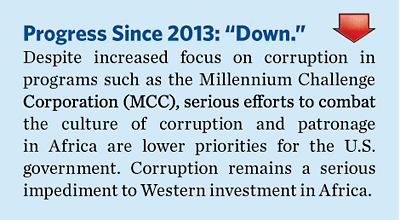
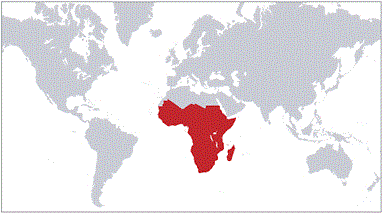
Action Needed: African governments must confront and reverse the endemic levels of corruption and improve transparency and the rule of law. African governments need to adopt policies and practices that build trust and accountability with their citizenry and improve the overall investment climate to ensure economic freedom.
U.S. Policy Recommendation: Corruption is crippling sub-Saharan Africa’s growth potential and minimizing opportunities for U.S. investors in all of Africa. The rule of law is a critically important factor in attracting dynamic flows of global investment capital. If African countries are to harness their high growth rates to ensure long-term sustainable growth, their governments (and the U.S.) should prioritize anti-corruption and transparency measures. Rule of law and capacity-building programs will not succeed without an increased focus by African governments on transparency and anti-corruption efforts.
The U.S. government should prioritize the accountability of national and local governments by pursuing a more focused approach on building e-government capacity in African countries. The U.S. government should also place more emphasis on building stronger civil societies in African countries by empowering nongovernmental private voluntary groups to serve as watchdogs for corrupt government practices and individuals. The best means of fighting corruption is transparency.
Official development assistance (ODA) programs of the U.S. Agency for International Development (USAID), however, have tended to promote statist approaches to development that concentrate control of the market, create economic distortions and new opportunities for corruption, and promote dependence on the government. Traditional ODA thus has reinforced the problems (such as corruption) that undermine sustainable development.
That is why a decade ago, the U.S. government created the Millennium Challenge Account, designed to allocate assistance to African countries that have embraced the policies linked to economic growth. The objective criteria used by the Millennium Challenge Corporation, which funds the account, to determine which countries will receive funding—how justly they govern, how well they invest in their citizens, and how much they encourage economic freedom—mirror the core principles of the Index of Economic Freedom.
At the core of the MCC approach is a hard focus on corruption. Participation in MCC programs requires recipient governments to take high-level ownership of the funded projects and commit to reducing corruption and improving transparency and accountability, creating the “MCC effect.” MCC programs to promote sustainable economic development deal with such areas as transportation, water and industrial infrastructure, agriculture, education, private-sector development, and capacity building.
Since 2009 under the Obama Administration, however, the MCC has tended to fund projects that stray far afield of the core MCC mandate of anti-corruption and rule of law—projects that promote such goals as energy-efficient and lower-emissions household appliances and wind farms. Nevertheless, it is precisely the weak judicial systems and official and private-sector corruption in sub-Saharan Africa that are the most significant impediments to democratic institutions and economic development and growth. To really help Africa, the U.S. must return to the original MCC model.
Encouraging African Economic Integration
Africa faces major economic and governance challenges as it seeks to achieve a macroeconomic growth agenda capable of integrating the entire continent into the global economy and lifting some 400 million Africans out of extreme poverty. The windfalls from exports of natural resources that many African countries have enjoyed in recent years will only make continent-wide economic integration even more critical to participation in the global economy and to helping sustain economic growth.
Former United Nations Secretary-General Kofi Annan observed more than a decade ago that open markets are the only realistic way to pull hundreds of millions of people in developing countries out of abject poverty. Yet Africa has yet to exploit the power of market-oriented growth. Formal intra-African trade remains at a dismal 10 percent, the lowest of any region in the world. In order to expand the region’s trade potential, a bold plan for greater continent-wide integration needs to be developed expeditiously and put into action. Greater African market integration is being pursued by the African Union in an effort to establish a Continental Free Trade Area (CFTA) by 2017 and integration of the Regional Economic Communities into a single customs union with a common currency, central bank, and parliament by 2028. Complex customs unions, administrative procedures, and burdensome regulations continue to hinder CFTA negotiations.
The U.S. has attempted to develop a strategic market access approach to Africa, albeit a limited one. Congress enacted the African Growth and Opportunity Act (AGOA) in May 2000 and has extended it twice. The act is due to expire again in 2015. AGOA is a trade-preference program structured to promote growth by reducing American barriers (tariffs, for instance) to African exports. More than 30 sub-Saharan African countries benefit from AGOA membership. Exports from AGOA-eligible countries to the U.S. in 2012 were more than twice the level of 2000, and U.S. exports to these countries more than tripled.
Action Needed: Increasing intra-African trade and market integration is necessary in order to expand Africa’s role in global trade. Ensuring dynamic competitiveness and long-term development in sub-Saharan Africa depends greatly on increasing the competitiveness of African entrepreneurs through expanded economic freedom. The African Union should prioritize market integration and provide leadership in countries that lack the domestic political will to pursue integration by more clearly articulating how market integration fosters economic growth.
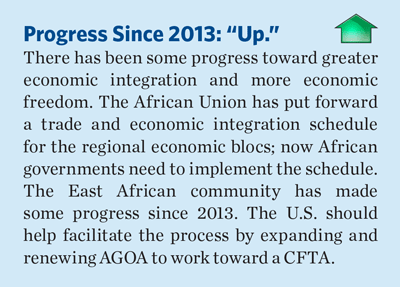
U.S. Policy Recommendation: The U.S. should not only renew AGOA through 2025, but also use the legislation to spur African economic integration (through the CFTA) and ultimately transform the trade-preference program into an FTA between the U.S. and Africa. With improved policy environments and a rich natural resource endowment, many economies in the region have become more attractive trade and investment destinations for the rest of the world. The U.S. should no longer regard African countries primarily through the assistance lens, but increasingly as viable economic trading partners. The U.S. should endorse and incentivize economic integration. AGOA should reward African progress toward integration and economic freedom.
Foreign Investments for Greater Prosperity
Continued economic growth and expansion of freedom in sub-Saharan Africa will require inbound investment. In Africa, mobile telephony technology is exploding, discoveries of natural resources continue, and 60 percent of the world’s arable land remains uncultivated. Foreign direct investment (FDI) in 2013 grew by 34.4 percent to $43 billion (from $32 billion in 2012). Meanwhile, Africa’s middle class is growing: It is already collectively larger than India’s, and by 2020, 50 percent of households will have discretionary spending power.
Yet FDI in sub-Saharan Africa has been hindered by political unrest and economic uncertainties. Investors’ concerns over taxation issues and the absence of specific investment protections, particularly for U.S. investors, mean that many of the positive changes occurring on the continent remain unrealized. Countries such as China play by different rules; their opaque investments in extractive industries may help build a port, a highway, or a railroad in Africa today, but they carry with them a potentially bitter legacy of corruption and nepotism.
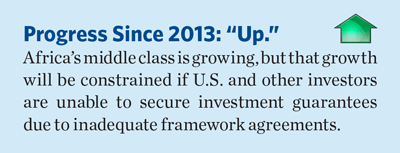
Action Needed: Sub-Saharan Africa needs sound domestic policies that will increase foreign investment to facilitate international trade and economic growth. Free and open investment regimes provide maximum entrepreneurial opportunities and incentives, expanded economic activity, greater productivity, and job creation. Intra-regional and global trade in Africa will require serious investments in infrastructure. In order to attract more FDI in such projects, African governments need to create effective investment frameworks—characterized by transparency and equity—and support investments from all firms, not just those that are large or politically well-connected, in order to encourage innovation and competition.
U.S. Policy Recommendation: The U.S. government should refocus its development policy on trade and investment with sub-Saharan African countries and make a priority of vigorous pursuit of an expanded commercial agenda that makes investment in sub-Saharan Africa more attractive to the investor—for instance, by establishing a broader network of BIT, and negotiating double-taxation treaties (DTTs) that remove fiscal burdens from investment-oriented capital flows. These concrete actions would advance the discussion beyond “trade, not aid.” Negotiating a greater number of U.S. BITs and DTTs with African governments would be a catalyst for U.S. investment in some of the fastest-growing economies in the world.
Property Rights Protection
Lack of property rights is a significant challenge to economic growth. In sub-Saharan Africa, the historical obstacles to protecting property rights and threats to economic freedom range from traditions of tribal and communal ownership and land holdings to restrictions based on race (South Africa’s former apartheid system) to experiments with expropriation and uncompensated redistribution (Zimbabwe under President Robert Mugabe) and failed collectivization under communist and socialist economic models.
Another major hindrance to economic development is more administrative in nature: the absence of formal property titles and documentation proving ownership of land holdings, a situation that creates legal insecurity and economic vulnerability for small and medium producers. The average property rights score is weakest in sub-Saharan Africa and is second only to freedom from corruption as the lowest indicator in the Index for the region, highlighting the fact that, overall, weak rule of law in Africa remains the largest challenge to improving region-wide economic freedom. Expropriation remains on the South African government’s official policy agenda; current legislation threatens to reopen the land claims process. These actions would be detrimental to both domestic and foreign private property owners.
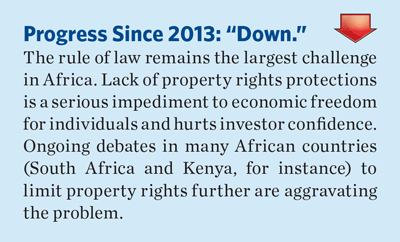
Action Needed: Sub-Saharan African nations must pass and enforce laws to expand the coverage of and provide documentation for private property holdings. In some countries, only a small percentage of land is covered by the property cadastre. Secure property rights give citizens the confidence to undertake entrepreneurial activity, save their income, pledge collateral for loans and mortgages, and make long-term plans. African governments still lack effective and independent judiciaries capable of protecting property rights and enforcing contracts because they remain susceptible to corruption and political maneuvering.
U.S. Policy Recommendation: The U.S. should work with international financial institutions, such as the International Monetary Fund (IMF) and the International Finance Corporation of the World Bank, international development assistance cooperative partners from other Organization for Economic Co-operation and Development (OECD) countries, and other sub-Saharan African nations, to prioritize programs that establish and strengthen judicial institutions and rule of law to protect property rights. The U.S. (through reprioritizing existing USAID and MCC programs) should develop a specific and high-profile strategy to provide technical assistance to sub-Saharan African countries to develop appropriate legal norms and land-titling processes, as well as supporting property-mapping initiatives.
2014 Economic Freedom Global Agenda by Region: North America
The North American region (home to the three NAFTA partners—the United States, Canada, and Mexico) has long benefited from its relative openness to international trade and investment. Although it enjoys the highest level of economic freedom of any region in the world, those levels have fallen in recent years. North America scores above the world average in eight areas of economic freedom. It has high levels of business freedom, trade freedom, monetary freedom, and labor freedom. Weaknesses remain due to high government spending in the United States and Canada, and improvements are needed in protection of property rights and freedom from corruption in Mexico. Mexico lags significantly behind its two northern neighbors in these two areas, which are critical to long-term economic development.
Enhancing Economic Cooperation Through NAFTA
2014 marks the 20th anniversary of the regional North American Free Trade Agreement. NAFTA has increased income levels, employment, investment, and trade. It has been a positive force, connecting more than 450 million people in an economic area producing about one-third of the world’s total GDP. Employment in North America has increased by an average of more than 25 percent—35 percent in Canada, 49 percent in Mexico, and 18 percent in the U.S.—due to the creation of millions of jobs in each country since NAFTA took effect. After adjusting for inflation, per capita income is up in all three countries: an average increase of 35 percent in the U.S., 37 percent in Canada, and 21 percent in Mexico, which translates into an average increase in per capita income of 35 percent per person in North America. The total value of all foreign direct investment has increased by about $3 trillion in the United States, $527 billion in Canada, and $282 billion in Mexico. Trade volume for North America measured in constant 2005 dollars has more than doubled to $4.9 trillion.
Efforts are ongoing to improve U.S.–Canadian trade flows through the joint “Beyond the Borders Action Plan.” This plan includes several measures to facilitate trade and economic growth in both the United States and Canada. These include speeding up customs procedures, eliminating duplicative screening, and implementing new technologies to facilitate cross-border shipments of goods. For example, the action plan aims to enhance the benefits of programs that help trusted businesses and travelers move efficiently across the border by strengthening “trusted trader” and “trusted traveler” programs and eliminating supply chain bottlenecks. Similarly, the plan also calls for both countries to speed clearance for cargo through new pre-screening and pre-clearance procedures. These efforts are to include offering a “single window” for importers to submit information required by various government agencies electronically, expediting clearance for low-value shipments, facilitating trade by improving transparency and accountability for border fees, and improving infrastructure at border crossings.
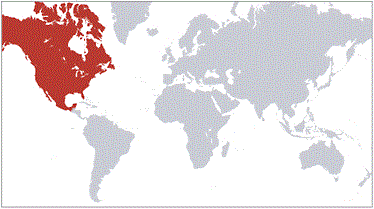
Despite the existence of NAFTA, barriers to trade remain. To combat these remaining barriers, all three countries are participating in TPP talks which, if successful, could further liberalize trade. In addition, Canada and Mexico have each unilaterally reduced tariffs in order to boost their international competitiveness.
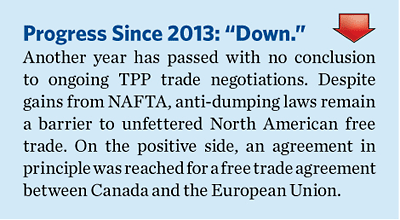
Action Needed: Political leaders need to respond effectively to parochial concerns about increased competition and economic restructuring in specific sectors. These concerns must not be allowed to obscure the overall benefits to the U.S. economy of NAFTA’s trade liberalization. All countries should work through the TPP to remove barriers to international trade and investment.
U.S. Policy Recommendations: Protectionist measures and excessive enforcement actions reduce the efficiency of the North American economy and hurt prosperity in all three countries. Protectionist measures should be resisted, and the United States should be prepared to reduce trade barriers both through the TPP and unilaterally, as Canada and Mexico have done. The U.S.–Canada Beyond the Border Action Plan to facilitate trade while addressing legitimate security concerns should continue to be implemented.
Mexico: Still Behind Its North American Neighbors but Catching Up
Promoting economic freedom in Mexico is key to addressing joint economic, security, and civil society concerns. Enrique Peña Nieto began his single six-year term as president of Mexico in December 2012. Since then he has taken many positive steps to challenge the private and public monopolies and duopolies that have historically dominated and hampered huge portions of Mexico’s economy.
These combines—in energy, telecommunications, construction, food production, broadcasting, financial services, and transportation—have long been a drag on competitiveness and job creation. Notwithstanding Mexico’s NAFTA membership, these sectors were effectively “roped off” to benefit politically powerful rent-seekers (a phenomenon known as “state corporatism”). This had the same practical effect as that of traditional protectionist trade barriers. Despite being the third-largest oil producer in the hemisphere and the 10th-largest in the world, Mexico’s oil industry has been in decline. Nevertheless, the historic energy reforms that the Peña Nieto government implemented in 2013 will open the doors for foreign investment in Mexico’s traditionally state-run oil company PEMEX.
The health of Mexico’s economy directly affects U.S. immigration patterns. The Mexican economy’s failure to perform at peak efficiency and realize its full potential over the past half-century has produced a flood of unemployed semi-skilled and unskilled Mexican workers seeking employment in the United States.
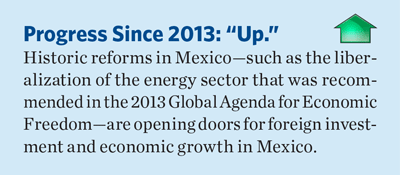
Action Needed: Mexico needs to continue to liberalize and open its economy. Recent moves to reform laws governing the labor and energy markets have been major steps in the right direction. The resulting flood of new private investment from these and additional reforms will create hundreds of thousands of new jobs that will encourage many would-be economic migrants to remain at home in Mexico.
U.S. Policy Recommendations: To the extent that they are subject to its jurisdiction, the U.S. Department of Justice should investigate the operations of Mexican monopolies and oligopolies, especially in the telecommunications, transportation, and energy sectors. The Justice Department should produce a report for the President that identifies these corporations and lays out any actions that the U.S. government can take to encourage viable domestic and foreign competition within these economic sectors in Mexico.
For too long, America’s immigration system has remained flawed and broken. Despite the effects of economic recession in the U.S., it is clear that many individuals from Mexico continue to come to the United States unlawfully to seek work. These unlawful immigrants currently receive government benefits far in excess of any taxes they pay, thereby imposing large costs on already overburdened U.S. taxpayers.
In response to these problems, the U.S. could experiment with a temporary worker program. A proper temporary worker program must ensure that the workers are truly temporary, are not on a pathway to citizenship, and do not have access to welfare, government entitlements, and costly education benefits. Temporary workers should never impose additional net costs on U.S. taxpayers. Any proposed temporary worker program should not permit unlimited, uncapped immigration into the nation and must not result in a de facto amnesty.
The economic goal of immigration policy and any temporary worker program should be to meet the needs of the U.S. economy and raise the after-tax incomes of American citizens and legal residents. Temporary worker programs are likely to be most effective if they are targeted to economic areas such as agriculture where temporary workers are clearly appropriate.
2014 Economic Freedom Global Agenda by Region: Asia–Pacific
The Most Improved Region
The 43 countries encompassing the Asia–Pacific region made the greatest gains in economic freedom of any region over the past year. The region, however, continues to be distinguished by its enormous disparities in this freedom.
The Asia–Pacific ranks noticeably above the world average in fiscal freedom, government spending, and labor freedom. The region does poorly in property rights, freedom from corruption, and financial and investment freedom.
While four of the world’s freest economies—Hong Kong, Singapore, Australia, and New Zealand—are in this region, many of the other Asia–Pacific countries remain “mostly unfree.” North Korea, which continues to reject any form of free-market activity, remains the world’s least free economy.
Leading the world in three of the 10 economic freedoms, Hong Kong once again is the world’s freest economy. Runner-up Singapore is beginning to close the gap with Hong Kong as a more dynamic and competitive financial sector emerges in the city-state. Australia and New Zealand continue to set the standard for clean, corruption-free government and benefit significantly from their transparent and efficient business environments and open-market policies.
India and China remain “mostly unfree.” Despite high economic growth rates, the foundation for long-term economic development continues to be fragile in the absence of effectively functioning legal frameworks. Progress with market-oriented reforms has been uneven and has often backtracked at the urging of those with a political interest in maintaining the status quo.
Last year’s focal points for Asia’s economic freedom agenda were land rights, a reduced role and privileges for SOEs, transparency to combat corruption, the harmful effects of an expansive monetary policy, and the private sector’s role in building infrastructure. While all of these subjects remain top priorities for the Asian economies, this year, the 2014 global agenda emphasizes financial liberalization, auditing and reporting standards, and privatization as focal points.
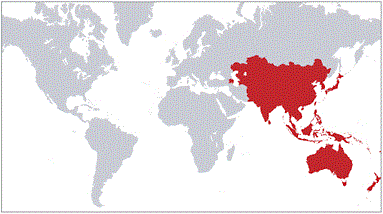
Financial Liberalization
One of the most pressing and critical issues currently facing the emerging economies is the continued development of their financial sectors. The banking sector dominates the emerging markets’ financial intermediation throughout Asia, but many are state-owned and allocate capital poorly. Many of Asia’s emerging stock markets, if they exist, are essentially illiquid (only five emerging Asian economies had active stock markets in 2013). Corporate bonds markets are nonexistent in most emerging economies, and many emerging-market consumers have no access to credit.
Unfortunately, the global financial crisis has led to a sweeping re-evaluation of financial market regulation. Basel III, for example, which mandates significantly higher capital and liquidity requirements for banks, was largely designed for Western institutions. The accord, scheduled to be fully implemented by 2018, simply ignores the fact that emerging economies are in earlier stages of economic and financial development and will require different regulatory regimes as they deepen their financial markets and democratize credit.
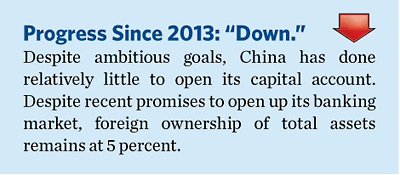
Action Needed: With financial laissez-faire economics dead, at least for the foreseeable future, countries should attempt to break the trend and preserve or implement financial-sector reforms that lead to greater financial freedom and, in turn, financial development.
U.S. Policy Recommendation: The U.S. should encourage countries with relatively closed financial systems to open them up to foreign competition. Banking and financial regulation by the state that goes beyond the assurance of transparency and honesty in financial markets will impede efficiency and should be removed over time in developed and developing Asian countries alike.
Auditing and Reporting Standards
Private-sector transparency is indispensable to investors, and it can be brought about through the use of good auditing and accounting practices that ensure access to accurate information in a timely manner. Public companies that are more open and accurate about disclosing their underlying business conditions have been found to trade at higher valuations and have lower costs of capital than their peers.
According to the World Bank’s 2014 “Doing Business” survey, Australia and Malaysia have some of the world’s best auditing and reporting standards in Asia, while emerging-market giants China and India receive mediocre scores. Vietnam has one of the worst standards.
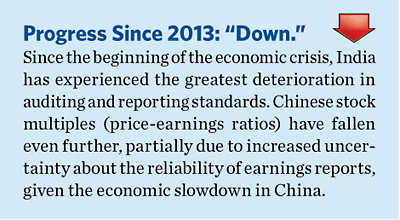
Action Needed: It should be obvious that it is difficult to attract investors without clear private-sector transparency, so adopting Western-style auditing and accounting standards is paramount. Listing on foreign exchanges with superior reporting standards (such as London, New York, or Hong Kong) has generally elevated a company’s auditing standards and valuations.
U.S. Policy Recommendation: Many Chinese public companies were delisted from U.S. exchanges in recent years due to poor auditing and reporting standards. More due diligence should be required before being allowed a listing on a U.S. equity exchange.
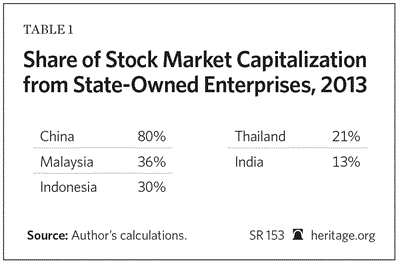
Resurrecting Privatization
Even after almost three decades of privatization worldwide, the role of the state in many economies remains strong if not dominant. Table 1 shows the SOE share of stock market capitalization of some of Asia’s larger emerging economies.
Corporate control can occur either through outright majority or minority equity positions in companies or through the provision of subsidized credit or other privileges to private companies.
The significant presence in Asia of SOEs is unfortunate because history has proven that markets are much better at allocating capital (picking winners) than state-owned or state-run financial institutions. State-owned or state-controlled enterprises come with enormous political strings attached. Markets have no agenda other than maximizing the financial return of investors.
With national debt in developed countries hemorrhaging since the Great Recession, wealthy countries (such as Japan) should also be considering privatization options. According to The Economist, state-owned enterprises in OECD countries are worth around $2 trillion.

Action Needed: China and India should take the lead in privatizing state-owned assets. Much of the banking sector in both countries is state-owned, leading to a misallocation of capital and creating systemic risk in their respective financial systems.
U.S. Policy Recommendation: The U.S. should set an example by privatizing its own state-owned assets. The federal government owns nearly one million buildings and about one-fifth of the country’s land area, much of which is well endowed with energy and other raw materials.
2014 Economic Freedom Global Agenda by Region: The Middle East and North Africa
Many of the countries in the Middle East and North Africa have undergone political and economic upheavals during the protests of the “Arab Spring,” but long-overdue economic reforms continue to be neglected or postponed due to political instability. As a result, the gradual rise in economic freedom that had been recorded in recent years has come to a halt. Structural and institutional problems abound, and the regional unemployment rate, which averages more than 10 percent, is among the highest in the world. The high unemployment rates, which are most pronounced among younger members of the workforce, have boosted political discontent, have undermined many governments, and continue to cast a long shadow on the region’s economic prospects.
The region’s problems are complex and rooted in decades of authoritarian rule, which has kept power and resources in the hands of a few. Simply holding elections or allowing freedom of expression will not solve these problems. Elections merely amplify political cleavages if there is no consensus on the rules of the game after the elections. Stable democracies require a supportive civil society, independent judiciary, respect for the rule of law, limited government, freedom of the press, religious freedom, and a decentralization of power, but as long as national economies are dominated by the state sector, political leaders will be reluctant to share power if that diminishes their access to state-controlled wealth. Difficult institutional reforms are required to reduce the state’s role in the economy and in peoples’ lives.
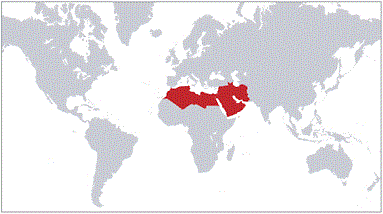
Middle East Dominated by Authoritarian and Corrupt Regimes
Many Middle East countries are dominated by authoritarian regimes that carve out significant portions of national economies for their own benefit or to provide patronage for their supporters.
The tragic human catalyst that ignited the “Arab Spring” was the young Tunisian food vendor Mohammed Bouazizi, who set himself on fire on December 17, 2010, after police confiscated his fruit and vegetable cart and humiliated him, apparently because he refused to pay them a bribe. Many young Tunisians identified with his plight and were inspired to join popular protests that ousted the corrupt authoritarian regime of President Zine El Abidine Ben Ali, who fled the country.
Government corruption not only squanders economic resources, but also restricts economic competition and hinders the development of free enterprise. Corruption was a major issue that helped to galvanize opposition to governments in Egypt, Libya, Syria, and Yemen. Entrepreneurs are unlikely to invest their capital or hard work unless they have a reasonable chance to earn a fair return for their efforts, free from the threat of government seizure or the interference of corrupt officials.
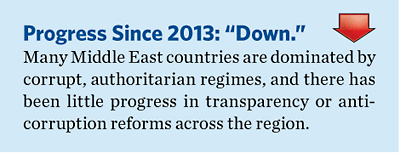
Action Needed: Ruling elites need to commit to a philosophy of limited government and the development of independent judiciaries and commercial legal frameworks that strongly protect property rights and ensure free competition.
U.S. Policy Recommendation: The U.S. should strengthen the OECD’s anti-bribery convention to address the sharp challenges in the Middle East. Transparency and anti-corruption practices in trade and investment should be emphasized in bilateral investment treaties and other economic exchanges. Private enterprise, a vital engine of economic growth, cannot flourish unless entrepreneurs are free to expand their businesses without fear of government confiscation.
Socialism Still Widespread in Arab Countries
In the 1950s, many Arab countries adopted socialist models for economic development, which curtailed economic growth, encouraged expansion of bureaucracies, and prompted the creation of inefficient state-owned industries. It is no coincidence that Egypt and Tunisia, the first two countries to experience the “Arab Spring” uprisings, had strong socialist legacies that created corrosive corruption and dysfunctional bureaucracies that were perceived to oppress rather than serve their citizens.

Action Needed: Arab countries must discard failed socialist ideologies and emphasize market reforms and economic liberalization.
U.S. Policy Recommendation: Washington should encourage Middle East governments to liberalize their economies, remove bureaucratic red tape, and encourage domestic and foreign investment to spur the development of vibrant private sectors. Expensive state-owned enterprises should be privatized wherever possible in a transparent and fair process to avoid the rise of crony corporatism. Expanding the private sector will fuel economic growth and help to create a larger middle class, an important building block for developing stable democracies.
Many Middle East Economies Too Small to Stand Alone
Many Middle East economies are too small to provide the range of goods and services that their people demand or need. In particular, many Middle Eastern countries import food, automobiles, machinery, electronic devices, and high technology from outside the region. Consumers would benefit from lower prices for these imported goods, which are sometimes discouraged by protectionist tariffs imposed to prop up uncompetitive local industries.
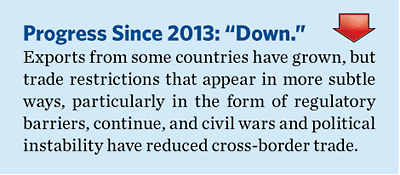
Action Needed: Trade freedom reflects an economy’s openness to the flow of goods and services from around the world and a citizen’s ability to interact freely as buyer or seller in the international marketplace. Trade restrictions can manifest themselves in the form of tariffs, export taxes, trade quotas, or outright trade bans. However, trade restrictions also appear in more subtle ways, particularly in the form of regulatory barriers. A reduction of government hindrances to the free flow of foreign commerce would have a direct and positive bearing on the ability of individuals to pursue their economic goals and maximize their productivity and well-being.
U.S. Policy Recommendation: The United States should try to negotiate bilateral FTAs with Middle East countries and encourage the formation of a regional free trade zone. FTAs could not only lower the costs of imported goods and help boost imports from the United States, but also expand exports to the U.S. market. Jordanian exports to the United States, for instance, skyrocketed from $229 million in 2001, when Jordan ratified the FTA with the U.S., to $1.3 billion in 2007. Although an FTA with Egypt may not be politically viable at the moment, Washington should encourage the expansion of the U.S. Department of Commerce’s Qualifying Industrial Zone (QIZ) program, which allows goods produced jointly by Israel and Egypt to enter the United States duty-free. This would have the ancillary benefit of encouraging greater cooperation between Egypt and Israel.
Iraq: More Reforms Needed
Iraq needs systematic economic reform in addition to political reforms to stabilize its political system. The country suffers from high rates of unemployment and heavy subsidies for food, oil, and natural gas products, as well as endemic corruption, all of which dim its economic and political prospects.
For decades, Iraq’s governments have imposed a wide array of constraints on economic activity. Though sometimes imposed in the name of equality or some other noble societal purpose, such constraints are in reality most often imposed for the benefit of elites or special interests, and they come with a high cost to society as a whole. By substituting political judgments for those of the marketplace, government diverts entrepreneurial resources and energy from productive activities to “rent seeking”—the quest for economically unearned benefits. The result is lower productivity, economic stagnation, and declining prosperity.
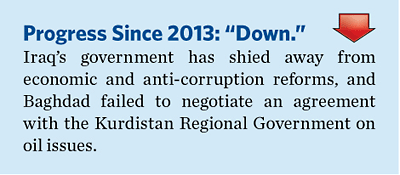
Action Needed: The Iraqi government must undertake systematic economic reforms to root out corruption in the swollen public sector, privatize government monopolies wherever possible, reduce government subsidies to consumers, and create stronger and more effective institutions to improve governance. It is particularly important to create a transparent and effective oil sector, which is the driving force of the Iraqi economy. The central government also needs to create a better business environment for foreign investors and reach an agreement with the Kurdish Regional Government on oil issues to boost exploration and development of Iraq’s huge oil production potential. Negotiations between the Iraqi government and the Kurdistan Regional Government reportedly were close to an agreement on this prickly issue in early 2014 but had not been completed.
U.S. Policy Recommendation: The U.S. should encourage the Iraqi government to undertake free-market economic reforms, root out corruption, reduce government subsidies, and create a transparent oil sector. It should also press the Shia-dominated government to reach out to Sunni and Kurdish Iraqi political parties and bring them into the ruling coalition. This will help reduce ethnic and sectarian tensions, undercut the appeal of al-Qaeda and other terrorist groups, and help to forge a national consensus that will enhance political stability and enable economic growth.
2014 Economic Freedom Global Agenda by Region: Central and South America and the Caribbean
Beyond the borders of the United States, markets in all of the other 28 countries in the Western Hemisphere comprise a total of 600 million people and account for trillions of dollars in international trade. Resource-rich countries in the Americas continue to profit from demand for commodities fueled by fast-paced growth in Asia and other markets, which is supporting sustained economic growth. Most regional economies have weathered the worst effects of the 2008 economic crisis and the recent European crisis. Millions of Latin Americans have risen from poverty. In fact, according to the World Bank, extreme poverty in Latin America and the Caribbean has declined by half in the past 15 years, and in 2011, for the first time in history, the region had a larger number of people in the middle class than in poverty. Yet the region’s economic freedom scores, according to the 2014 Index of Economic Freedom, range from excellent (Chile) to abysmal (Cuba and Venezuela), with a major player such as Brazil, the world’s sixth-largest economy, registering comparatively low scores because of a penchant for protecting local industries with high import tariffs and regulations, as well as swollen bureaucracies and over-regulation.
Despite forecasts of declining growth in many countries, there are many positive regional trends. Many Latin American countries are emerging as global leaders in free trade. The vast majority of the world’s pending FTAs either are based in the region or have regional participants. The Alliance of the Pacific (Chile, Colombia, Mexico, and Peru, along with potential members Costa Rica and Panama) is emerging as a praiseworthy model of regional economic integration that will enhance the prosperity of its member countries. Unprecedented energy reforms in Mexico stand poised to create abundant opportunities for U.S. energy companies.
Even with these positive developments, Latin American leaders must contend with many complex issues. While overall poverty levels have decreased, fundamental reforms are required to lift the burden from taxpayer-funded programs. Endemic security issues remain an obstacle to economic development. Protests and social upheavals in the past year in Brazil, Argentina, and now Venezuela demonstrate that citizens are not content with the extensive corruption and crony corporatism of their populist and authoritarian governments. The most recent demonstrations in Venezuela could be the final breaking point for the 15-plus-year reign of chavista socialism.
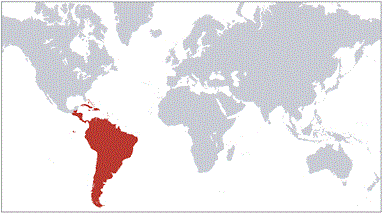
Regional Polarization: Pacific Alliance vs. ALBA
Findings from the Index of Economic Freedom show a polarized Latin America. On one side are countries that are consolidating their democracies and integrating their strengthening economies. The Alliance of the Pacific, a regional political and economic bloc, was founded in 2011 and has grown stronger since then. The Pacific Alliance also helps the United States, providing a healthy and pro-Western alternative to the state-centric and anti-American bloc of countries led by Cuba and Venezuela. The Pacific Alliance aims to synchronize and deepen its members’ trade commitments and to enhance trade and investment with the bloc’s dynamic partners in East Asia.
On the other side is the bitter legacy of the late Venezuelan president Hugo Chavez. His “21st-century socialism” model and its regional economic bloc, known as the Bolivarian Alliance (ALBA), have produced much misery and lower living standards. Led by populist authoritarian caudillos (strongmen), the countries of Venezuela, Bolivia, Ecuador, and Nicaragua have been transformed into welfare dependencies featuring extreme (and unsustainable) social spending programs, strong protectionism, and exclusionary policies. Indicators measuring healthy democracies have plummeted in ALBA member states. The rule of law has eroded, the judicial systems are increasingly politicized, and government policies have been hostile to private property rights.
The Index scores speak for themselves. The six economies of the Pacific Alliance are the most dynamic in the region, representing more than 40 percent of Latin America’s economy with a market of more than 210 million people—more than one-third of the region’s population. Since 2010, they have grown at a higher rate than have their neighbors and have also invested at a greater rate: 25 percent of their combined GDP, compared to 20 percent elsewhere. The Obama Administration should encourage the Pacific Alliance as the best way forward for all of Latin America.
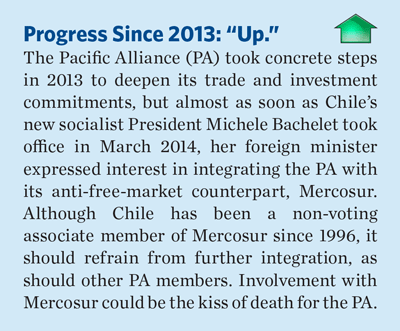
Action Needed: Other Latin American and Caribbean countries should emulate the steps taken by Pacific Alliance members.
U.S. Policy Recommendation: The United States should make every effort to support the Pacific Alliance; it presents the U.S. with a viable platform to wage the continuing war of economic ideas and overcome retrograde statist and authoritarian traditions. The region’s unsustainable economic policies and persistent failures—those associated with Venezuela’s Socialism of the 21st Century and Cuba’s outdated and failed Marxist economic model—are continually disproven. The data points outlining the performance of Pacific Alliance countries speak loudest. Virtually all indicators demonstrate the economic benefits of free-market policies advanced by the Pacific Alliance.
Citizen Insecurity in the Americas
Rampant levels of crime and violence in Latin America have reached a critical point. Latin America contains only 9 percent of the world’s population and is home to more than a quarter of the world’s homicides and around 60 percent of the world’s kidnappings. It is the only region in the world where lethal violence has increased. Diminishing state resources and weak state institutions inhibit the capacity of many of these governments. Of the 50 most dangerous cities in the world, Latin America is home to 41. The most dangerous city, San Pedro Sula (180 murders per 100,000 people), is also located in the most murderous country in the world: Honduras (92 murders per 100,000 people). (The comparable U.S. statistic is 4.7 on a nationwide basis). Caracas, Venezuela’s capital, is also extremely dangerous. In fact Honduras, El Salvador, and Venezuela share the dubious distinction of being the global leaders in homicide rates.
The cost of violence in these countries is hobbling their economies; in both Honduras and El Salvador, it translates into 10 percent of respective GDP. Venezuela loses 4.8 percent of its GDP to violence. Lack of public safety impedes human development, communities, and institutions. It also frightens off foreign direct investments and shaves percentage points off of potential economic growth. Citizen insecurity is also undermining the rule of law. In these and several other Latin countries, citizens have lost confidence in the state’s capability to protect them. Latin America now has almost 50 percent more private security guards than police officers.
Further undermining the rule of law is the growing support for the decriminalization and legalization of drugs, particularly marijuana. The seeming indifference to Latin America exhibited by Washington policymakers (at least in public) is jeopardizing the historic hemispheric leadership position of the United States. Regional institutions, such as the Organization of American States (OAS), have urged countries to explore options outside the U.S.-centric “war on drugs.” Uruguay, for instance, recently embarked on an experimental project to regulate the production, sale, and consumption of marijuana. Other countries (such as Guatemala) are also calling for reforms of international counternarcotics policies.
Latin American governments would also be better served by reforming poverty reduction policies that are designed to reduce incentives that lead to criminal behavior. Conditional Cash Transfer (CCT) programs have had some success in improving living standards (for instance, in Mexico and Brazil) and breaking the intergenerational transmission of poverty by conditioning payments on compliance with co-responsibilities intended to develop children’s human capital. Economic freedom, however, has done more for the poor throughout the world than any taxpayer-funded social program or welfare check ever could.
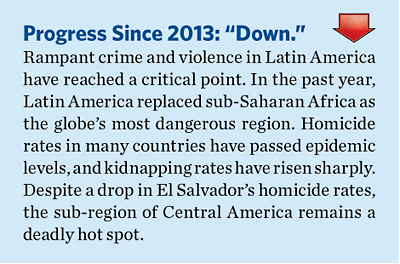
Action Needed: Latin American and Caribbean nations must continue to invest in improving security personnel and institutions to fight crime, deter violence, and build safer communities. Absent more investments by governments in these public goods, opportunities for economic growth will be constrained.
U.S. Policy Recommendation: The U.S. should continue to promote measures that enhance citizen security and the rule of law in the region. Multi-pronged, multi-year efforts must continue to build law enforcement institutions, courts, and corrective facilities through funding for new, follow-on initiatives to key programs, such as the Merida Initiative (Mexico) and the Central American Regional Security Initiative (CARSI). The U.S. must work domestically to reduce demand for illicit drugs and spearhead efforts to combat money laundering inside the U.S. and beyond. A CARSI-funded project to engage private-sector and civil society groups in Honduras, for example, would promote free-market policies and democratic reforms while also addressing drug-trafficking concerns.
Uprisings in Venezuela and the Future of Democracy
The foundations of economic freedom in Venezuela have crumbled. As one Latin pundit put it recently, “Brazil is becoming Argentina, Argentina is becoming Venezuela, and Venezuela is becoming Zimbabwe.” When the late Hugo Chavez took office in 1999, Venezuela scored 54 of 100 possible points in the Index of Economic Freedom. Today, after 15 years of authoritarian populism under Chavez and his successor Nicolas Maduro, Venezuela merits a score of just 36 points. This nearly 20-point plunge is among the most severe ever recorded in the history of the Index. Venezuela’s 2014 rank—175th of 178 countries—places it among the most repressed nations in the world, above only Zimbabwe, Cuba, and North Korea.
In recent months, the economic and security situation has become more acute. Strict currency controls and haphazard devaluations have decreased the Bolivar’s value against the dollar by almost 40 percent. The country boasts the highest levels of inflation and debt in Latin America. The Venezuelan government has also become an even graver threat to U.S. interests. Using the vehicle of the Bolivarian ALBA bloc, the Chavez and Maduro governments have spearheaded an unprecedented wave of anti-Americanism in Latin America. Over the past 10 years, ALBA member countries have expelled U.S. diplomats, shut down U.S.-funded counternarcotics programs, and generally hampered bilateral trade relations.
Countrywide demonstrations against the Venezuelan government have been taking place since February 2014. In response, the government has ordered security forces from the National Guard to use armed motorcycle gangs to crack down brutally on the democratic opposition. Over 1,000 peaceful protesters have been detained and dozens tortured. As of early April 2014, 40 people had been killed. The government has instituted a virtual media blackout: Domestic independent media are nonexistent, and Internet access has been cut off in many cities. While some foreign media broadcasters (CNN, for instance) are still reporting from Venezuela, they have been censored by the government for fear of losing their access or operating licenses.
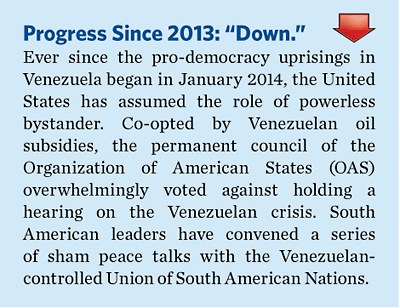
Action Needed: When uprisings began in Ukraine, the international community quickly condemned the government officials responsible for the violence and moved to impose sanctions against them as well. There has been no comparable response with regard to Venezuela. Further echoing this deafening silence is the OAS itself. Although required to do so by the Inter-American Democratic Charter, the Secretary General of the OAS has refused to hold the Venezuelan government responsible for this senseless brutality.
U.S. Policy Recommendation: The U.S. must send a clear message of solidarity to the democratic opposition and assure the protesters that the U.S. is committed to holding the Venezuelan government accountable for its violent reprisals. The Obama Administration should also impose targeted sanctions against those Venezuelan government officials who are already on the Treasury Department’s Office of Foreign Assets Control’s Specially Designated Nationals List, such as revoking U.S. tourist visas and freezing assets and accounts within the United States.
Within the U.S., the Obama Administration should support federal policies that increase development of domestic energy sources, such as opening up federal lands and waters to hydro-carbon exploration and development, devolving environmental review and permitting decisions to state regulators, approving the Keystone XL pipeline, and preventing federal regulations on hydraulic fracturing. While Venezuelan oil imports have decreased, they still make up 9 percent of U.S. foreign oil purchases. American dependence on Venezuelan oil constrains the U.S. government’s policy options.
2014 Economic Freedom Global Agenda by Region: Europe
There has been a significant realignment of European countries in terms of economic freedom in recent years. Eighteen European countries recorded their highest economic freedom scores in the 2014 Index, while five others scored equal to or below their rankings from nearly two decades ago. Ten of the world’s top 20 freest economies are in Europe, and the region scores above the world average in seven of the 10 economic freedoms, leading the world in trade freedom, investment freedom, and monetary freedom.
Taken as a whole, the Europe region is undergoing a tumultuous and uncertain period epitomized by the ongoing sovereign debt crisis in Europe’s south. Europe’s overall economic freedom is seriously undermined by excessive government spending to support elaborate welfare-state policies that are hindering productivity growth and job creation, causing economic stagnation, encouraging low birth rates, and rapidly increasing levels of public debt. Many European countries have been slow to implement the austerity measures required to reduce public spending. Many among Europe’s elite appear to believe that more European integration, not prudent economic policies, is the answer to Europe’s problem.
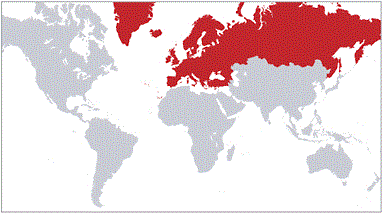
The Continuing Crisis in the Eurozone
Since late 2009, the 18 European Union members that use the euro (of 28 total members) have been beset by sovereign debt crises, and there is no sign of improvement. Germany sees the eurozone crisis as its number one challenge. Cyprus, Greece, Ireland, Portugal, and Spain have received multibillion-euro aid packages financed by their eurozone partners and the IMF. European leaders are desperately seeking a way to keep the eurozone together without addressing the root causes of the crisis. The aid recipients have adopted stringent austerity measures in exchange for the aid, but their populations are deeply dissatisfied with any spending cuts.
Although the eurozone finally grew enough to exit its recession by the second quarter of 2013, economic activity is still well below the peak it reached in 2008 before the full onset of the financial crisis. Nor has 2013’s meager economic growth translated into more jobs. Unemployment across the 18-country bloc stands at 12 percent. At nearly 27 percent, Spain has the highest unemployment rate in the European Union, and Spain’s youth unemployment is more than twice as high at 57 percent. Cyprus—a major offshore banking center for Russian cash—is still reeling from the effects of its 2013 bank solvency crisis. Some members of the eurozone, such as Greece, are still on the verge of a sovereign default while a few, such as the three Baltic States, have bucked the trend and are enjoying vibrant economic growth.
U.S. banks hold some eurozone debt and would take a hit in the event of a default, but the deepest effects would likely be felt through the interconnected global financial system. U.S. exports to European markets would start to fall off and could decline markedly. Furthermore, the U.S. could be affected by EU Commission proposals such as an EU financial transaction tax (FTT), a precursor to a global tax on financial trades (amounting to a “Tobin tax”). Arguably, it was the drive for monetary, fiscal, and political integration in the late 1980s and early 1990s that caused the current crisis.
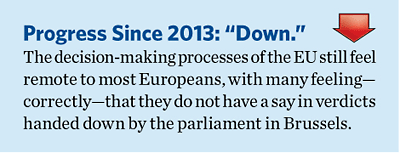
Action Needed: The European Union must decide whether it will pursue deeper fiscal and political integration, which would concentrate even more power in the hands of the European superstate. EU leaders in Brussels should put the question to voters and not decide this important question unilaterally or undemocratically.
U.S. Policy Recommendation: The United States should not participate in bailouts of eurozone countries. The United States should adamantly refuse to participate in a global FTT and should counsel the EU to avoid such a self-destructive move.
The EU’s Economically Destructive “Common Agricultural Policy”
Although it has recently been scaled back somewhat as governments attempt to impose some so-called austerity measures in Europe, the EU still spends more on its Common Agricultural Policy (CAP) than it does on any other part of its budget. The CAP funds direct payments to farmers, rural development initiatives, and food export subsidies. The CAP was one of the EU’s first supranationalist policies and is its single largest expenditure, accounting for nearly 40 percent of the European Union’s total budget.
Some of Europe’s largest companies receive government aid—such as Doux, a French conglomerate that is Europe’s largest poultry producer, and major sugar producers, including Belgium’s Raffinerie Tirlemontoise and France’s Saint Louis Sucre. As is the case for the billions of dollars allocated in annual U.S. farm subsidies, the CAP has become a byword for corporate welfare. It has also resulted in higher food bills for many European consumers and undermined development in poorer countries in Africa. The Common Fisheries Policy (CFP), another such program, has witnessed a dramatic decline in employment in the fishing industry as well as dangerously low fish stocks in the Mediterranean and Atlantic.

Action Needed: The EU’s Common Agricultural Policy must be reformed before it bankrupts EU governments. (Likewise, expensive and unwarranted U.S. farm subsidies must also be reined in.)
U.S. Policy Recommendation: As part of efforts to conclude the Doha Round successfully, individual European countries, the EU, and the U.S. should pledge to eradicate all agricultural subsidies by 2015, including the EU fisheries subsidies. This should also be the aim of the Transatlantic Trade and Investment Partnership negotiations. Europe and America should announce that they will fully open their agricultural markets to the world and allow developing nations to make use of their comparative advantages in this sector.
Free Trade with U.S. Will Help, but Won’t Solve EU’s Problems
The United States and the European Union have begun the negotiation of the Transatlantic Trade and Investment Partnership, which could greatly reduce or eliminate both tariff and non-tariff barriers to trade between the U.S. and the EU, a trade relationship that accounts for about 30 percent of world trade. However, even the most generous estimates under the best conditions show that a free trade deal would add less than 1 percent to the economies of the U.S. and Europe. While this addition would be welcome, it would not be the game changer claimed by many TTIP proponents on both sides of the Atlantic.
While a TTIP that resulted in concrete and measurable reductions of trade and investment barriers would be welcome, there are reasons to be concerned even at the early stages of negotiations that the TTIP will not promote free trade but instead will build a transatlantic managed market. The ramifications of such managed trade would, in practice, diminish or even eliminate apparent U.S. gains from the TTIP and would not promote economic freedom. The U.S. should therefore continue TTIP negotiations cautiously and assess any agreement based on analysis of its overall merits.
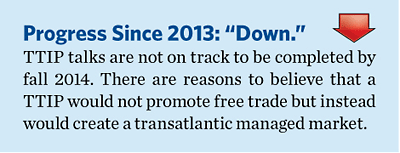
Action Needed: Notwithstanding any talks about future trade agreements, European leaders should be promoting existing free trade and transatlantic investment between the U.S. and Europe from a bilateral perspective even as TTIP negotiations continue. Peripheral issues—such as Edward Snowden, the NSA, and other public controversies that some in Europe seek to attach to a TTIP—should be ignored in the negotiations.
U.S. Policy Recommendation: The U.S. should be prepared to support a TTIP that empowers consumers and opens market opportunities for entrepreneurs. The U.S. should not start cheering for a TTIP before it confirms conclusively that the agreement is not a Trojan horse for increased regulation and the importation of the EU’s managed market into the U.S. Such an agreement would be a bad deal for everyone, especially the United States.
Stopping EU Political Integration, Bringing Back the Nation-State
Europe needs to return to the fundamentals of democracy. Power needs to be brought back to the member states and to the people. The intrusive and excessive EU regulations need to be curtailed. The wasteful spending in Brussels needs to end. Economic policies of growth need to be pursued. The excessive borrowing and entitlement programs need to stop.
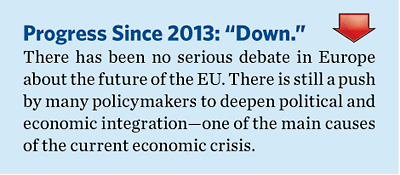
Action Needed: Instead of increasing policy competencies in opaque institutions in Brussels, power should be returned to the member states and to the people. This will promote economic freedom in Europe.
U.S. Policy Recommendation: Instead of calling for deeper political and fiscal integration among eurozone members, the U.S. should uphold the principles of sovereignty and democracy when framing its policy toward Europe.
2014 Economic Freedom Global Agenda by Region: Russia, Ukraine, Central Asia, and the Caucasus
Corruption and Authoritarianism Continue to Plague Russia
Russia is the largest country on Earth. It is blessed with tremendous natural resources, including hydrocarbons, minerals, and timber, as well as an educated workforce. Its economic development, however, is stunted: Mismanagement, corruption, abysmal rule of law, poor protection of property rights, and crumbling infrastructure all impede prosperity. Capital flight surpasses foreign investment. The Russian Federation currently ranks 92nd in the World Bank’s 2014 “Doing Business” survey and 127th in Transparency International’s 2013 Corruption Perceptions Index.
For years, the Kremlin has ignored high-level corruption: The authorities’ grip on power and graft remains unrelenting, as was highlighted in preparations for this year’s Winter Olympics in Sochi. The Olympic Games cost the Russian public over $50 billion, and more than half of it was stolen by Russian officials. As Boris Nemtsov reported last year (“Winter Olympics in the Sub-Tropics: Corruption and Abuse in Sochi,” translated in The Interpreter), all of the major construction projects in Sochi were allegedly awarded without public tenders or competitive bidding, to President Putin’s cronies, and not a single official responsible for the huge embezzlement of funds was imprisoned.
In Russia, the politically cohesive ruling circle controls the Duma (parliament), the law enforcement and security services, the courts, the state-owned companies, and the national television stations. In the absence of political and economic freedom and the rule of law, capital flight will continue, and popular support of the government will remain questionable. Deep reforms are impossible without democratization and liberalization, which the Kremlin desperately resists. Instead, it distracts the Russian public and seeks additional sources of revenue with its dangerous incursions to grab additional territory in neighboring countries of the former USSR (most recently in Ukraine and Georgia).
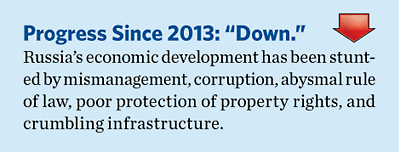
Action Needed: Russia must undertake wholesale reform of the legal system, strengthening the rule of law and the fight against corruption.
U.S. Policy Recommendation: In 2012, the U.S. Congress took the action that the Russian Duma should have taken years ago by passing the Sergei Magnitsky Rule of Law Accountability Act. This U.S. law matches the best of America’s interests with the best of its ideals. It names the corrupt officials involved in the death of Sergei Magnitsky, a whistleblower who worked as an auditor at a private Russian law firm and made credible allegations of massive corruption by Russian government officials. The Magnitsky Act will prevent those responsible for his death (and for other gross and systematic violations of human rights) from investing in and visiting the United States. The U.S. government should expand the list of names of corrupt Russian officials in the Magnitsky Act in the wake of Moscow’s illegal annexation of Crimea. Many of Russia’s leading violators of human rights also travel to Europe, vacationing and investing there. Therefore, European legal norms against such officials would be even more effective. It is time for the U.S. and its allies to hold these human rights violators accountable and time for the U.S. to call on the European Union to adopt similar measures.
Russian Ruble Devalues and Remains Volatile
The continuing devaluation of the ruble creates concern about the stability of Russia’s economy. In 2013, Russia’s economic growth slowed to a rate of 1.3 percent, the slowest since the 2008 financial crisis, and as Olga Tanas and Vladimir Kuznetsov reported in January on Bloomberg.com (“Russian Economic Growth Slows More than Estimated in 2013”), there is a 33 percent probability that Russia might fall into another recession in 2014. This was prior to the imposition of Western sanctions over the invasion of Crimea in February, so now the probability of a recession is even higher.
In 2013, the ruble dropped to a five-year low. This was a result of strengthening the dollar and the euro, which had a similar effect on other currencies in the emerging markets. The devaluation of the ruble was exacerbated by decreased investment activity and capital flight; the ruble remains volatile.
Russia’s Central Bank has made only minimal efforts to stabilize the ruble, as it plans to allow Russia’s currency to fluctuate freely by 2015. While the bank’s measured response looks to minimize the ruble’s long-term volatility, it will increase the cost of imported goods and escalate inflation.
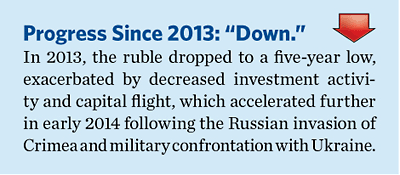
Action Needed: The Russian government needs to implement the necessary reforms to improve Russia’s business environment as the best means of stabilizing the ruble.
U.S. Policy Recommendation: A free-floating currency exchange rate ensures more competitive and fairer trade practices between countries. Therefore, the U.S. should encourage Russia’s Central Bank to continue its effort of allowing the ruble to float freely. Also, the U.S. and the international community should insist that the Putin administration end its aggression toward Ukraine, cease interference in its internal affairs, and reverse its occupation of Crimea. Russia’s illegal annexation of Crimea led to U.S. and EU sanctions against Russia that resulted in the downgrading of Russia’s credit outlook by Standard and Poor’s, which led to a further weakening of the ruble.
If Russia continues its aggression against Ukraine, it will face far tougher economic sanctions that are likely to force it into another recession and will impede its long-term economic recovery. It is in Russia’s own economic interests to respect the sovereignty of Ukraine and withdraw its occupying forces from Crimea.
Russia’s Banking Industry Cleanup
Russia loses hundreds of billions of dollars annually to shady banking transactions, including tax avoidance, money laundering, and theft of budget funds. As the Central Bank accelerated the cleanup of Russia’s banking sector, it revoked over 30 banking licenses in just the second half of 2013.
The rapid closure of banks across Russia negatively affects the Russian economy, creating doubts about the future of Russia’s financial system. While the industry cleanup may be necessary, its hasty implementation caused problems with money transactions throughout the country and further weakened the ruble, lowering investment-sector confidence. Also, as people lose confidence in the private banks, they deposit their savings in the inefficient and corrupt government-owned banks that dominate the industry.

Action Needed: Russia should continue the banking industry cleanup while ensuring that the private banking sector remains competitive.
U.S. Policy Recommendation: Greater transparency in Russia’s banking industry as a whole is needed to curb the banks’ illicit activities. The United States and its allies should encourage Russia to pass and implement the necessary banking reforms to move toward greater transparency in the financial sector.
Kazakhstan’s Central Bank Drastically Devalues the Tenge
On February 11, 2014, the Kazakh Central Bank devalued the national currency, the tenge, by 19 percent. Ye Xie and John Detrixhe reported in February on Bloomberg.com (“Emerging-Market Shakeout Putting Reserves Into Focus: Currencies”) that the weakening Russian ruble and dwindling of Kazakhstan’s international reserves to the lowest point since 2009 were contributing factors in the Central Bank’s decision. Another factor was the Kazakh government’s need to protect the country’s manufacturing sector against the higher levels of imports that were driven by the tenge’s strength. Kazakhstan’s current-account surplus, as reported in February by Nariman Gizitdinov on Bloomberg.com (“Kazakh Devaluation Shows Currency War Stirring as Ruble Dips”), dropped 82 percent in 2013.
Over the years, Kazakhstan has enjoyed an economic prosperity based mostly on exploitation of its abundant mineral wealth—primarily hydrocarbons, but also uranium and ferrous and non-ferrous metals. The devaluation of the tenge will drive labor costs down and will likely increase Kazakh exports and benefit the natural resources sector. The devaluation sparked some limited protests in the capital, Astana, as people expressed fears that such a drastic devaluation would increase inflation and lower living standards.

Action Needed: The high commodity prices in recent years led to overvaluation of the tenge. Therefore, the Kazakh government should develop policies leading to diversification of the economy by boosting the agriculture, manufacturing, and services sectors.
U.S. Policy Recommendation: Kazakhstan and the adjacent Central Asia region are strategically poised for economic growth, since the Chinese and East Asian markets, to which they supply raw materials, are growing. U.S. businesses should take advantage of opportunities in Kazakhstan, as Russia and China are already doing. The U.S. can also help Eurasian countries to deal with challenges in education, health, and environment, as well as security threats to their economies such as terrorism. Kazakhstan is aspiring to join the WTO, and the U.S. can assist Kazakhstan in making the adjustments necessary to do so. One of those steps would be to pull away from Vladimir Putin’s Eurasian Customs Union, a retrograde structure that serves only the interests of Russia.
Ukraine Faces Default, Desperately Needs Financial Assistance
Even without Crimea, Ukraine’s developed industrial infrastructure, large size and population, and proximity to both the EU and Russia make it one of the biggest European markets. It has a strong industrial base, an educated workforce, some of the best agricultural land in the world, and potentially large amounts of hydrocarbons, including shale gas, as well as offshore oil and gas in the Black Sea.
However, months of political turmoil in Ukraine that began late in November 2013, which led to the historically unprecedented ejection from office in February of President Viktor Yanukovych (allied with Vladimir Putin) and Putin’s subsequent invasion and occupation of the Crimean Peninsula, have put massive strains on an already struggling economy.
Now, with the ouster of President Yanukovych, the new provisional government led by Arseny Yatsenyuk is facing pressure to keep the country from defaulting. In February, Ukraine’s credit rating was downgraded by all major rating agencies; the national currency, the hryvnia, fell to a record low, and as Ukraine’s currency reserves decline, some observers expect the hryvnia to fall at least another 20 percent in the next year.
The U.S. Congress passed legislation to provide Ukraine $1 billion in financial aid in addition to the IMF agreement to deliver up to $18 billion in loans over the next two years. This is $16 billion short of the $35 billion that the Ukraine government estimates it needs to keep the country from economic collapse.
Although international aid will help stabilize Ukraine’s immediate financial problems, it is not sufficient to set the country on the path to a stable and sustainable economic future. Long-term financial health desperately requires the country to adopt deep economic reforms.
Ukraine also needs political reforms in order to fight rampant corruption, improve governance, and protect private property as well as foreign investment. This can be accomplished only after the May 25 presidential elections, after which the winner will appoint a new cabinet. Ukraine currently ranks as the 144th most corrupt country in the world in Transparency International’s Corruption Perceptions Index.

Action Needed: Ukraine must defeat corruption, improve governance, cleanse and revive the government’s civil service, reverse deterioration of its democratic and human rights performance, and improve the rule of law to achieve its economic potential.
U.S. Policy Recommendation: The U.S. and EU should ensure delivery of a financial aid package for Ukraine through direct assistance and the IMF. They should work closely with the new Ukrainian government to implement the reforms that would encourage growth of the Ukrainian economy and lessen its dependence on Russia. As a world leader in the oil and gas industry, the U.S. could also help Ukraine develop its oil, gas, and shale gas deposits in western Ukraine and the Black Sea area and prevent Russia from interfering in off-shore exploration. American technical expertise in these areas and others—such as in nuclear power safety—would match Ukraine’s needs well.
2014 Economic Freedom Global Agenda by Region: Arctic Region
The Arctic region encompasses the lands and territorial waters of eight countries (Canada, Denmark, Finland, Iceland, Norway, Russia, Sweden, and the United States) spread across three continents. Although, unlike in the Antarctic, there is no Arctic land mass covering the North Pole—just ocean—the region is home to some of the roughest terrain and waters, and harshest weather, found anywhere in the world. It is a region rich in minerals, wildlife, fish, and other natural resources. Some estimates are that up to 13 percent of the world’s undiscovered oil reserves and almost one-third of the world’s undiscovered natural gas reserves are located in the Arctic region.
The region represents one of the least populated areas in the world, with sparse nomadic communities and very few large cities and towns. Approximately half of the Arctic population lives in Russia, which ranks as just 140th freest (of 178 countries) in the 2014 Index of Economic Freedom.
The melting of Arctic ice during the summer months causes challenges for the U.S. in terms of Arctic security but also new opportunities for economic development. A decrease of ice will mean new shipping lanes opening, increased tourism, and further natural resource exploration. Many of the shipping lanes currently used in the Arctic are a considerable distance from search and rescue facilities, and natural resource exploration that would be considered routine in other locations in the world is complex, costly, and dangerous in the Arctic.
However, the Arctic also offers many opportunities. As ice continues to dissipate during the summer months, new shipping lanes have offered additional trade opportunities. For example, using the Northeast Passage along the Russian coast reduces a trip from Hamburg to Shanghai by almost 4,000 miles, cuts a week off of delivery times, and saves approximately $650,000 in fuel costs per ship. Unlike in the Gulf of Aden, there are no pirates operating in the Arctic currently, and they are unlikely to be a problem in the future.
Although economic activity is limited in the Arctic region, it will increase in the future, offering new opportunities for those who live there. Countries bordering the Arctic should not wait until it is too late to start implementing policies that promote economic freedom in the area.
Incentives for—Not Restrictions on—Economic Activity
The opening up of new shipping routes and increasing tourism and natural resource exploration are creating new challenges and opportunities for economic security.
Russia, for example, has suggested that new fees might be levied on commercial shipping passing through the Northern Sea Route. Canada claims that the Northwest Passage traverses internal Canadian waters that are not available for innocent passage. Restricting the flow of maritime traffic will have a costly and unnecessary impact on economic freedom in the region and around the globe. Unnecessary or excessive bureaucratic and administrative requirements to transit waters in the Arctic could lead to higher prices of goods for consumers, discourage economic activity, and limit economic freedom.
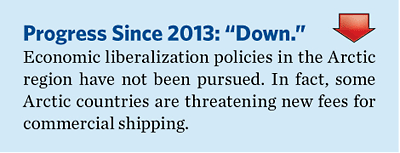
Action Needed: It is in the interest of all parties to pursue policies that encourage and promote economic freedom in the Arctic region. This includes the free movement of goods and people where possible and appropriate.
U.S. Policy Recommendation: The U.S. needs to work with Russia and Canada to ensure that shipping lanes stay available to commercial traffic. Furthermore, the U.S. should use its Arctic Council chairmanship from 2015 to 2017 to promote economic freedom in the Arctic.
Secure and Stable Arctic = Greater Economic Freedom
The harsh environment in the Arctic affects many capabilities that are required for economic activity in the Arctic. Search and rescue stations are often few and far between, limiting the frequency and distance of commercial shipping in the region. Communication technologies taken for granted in most other places in the world, such as high-frequency radio signals and the Global Positioning System, are relatively poor due to limited availability of satellite geometry and other environmental conditions in the Arctic. Existing U.S. civilian and military capabilities required to achieve good situational awareness are also being downgraded due to underfunding. That will simply make an already bad situation worse. It will also limit economic activity in the region.
As elsewhere in the world, economic freedom in the Arctic would be furthered hampered by conflict and instability. Fortunately, there is a very low threat of armed conflict in the Arctic, and it is in the world’s interest to keep it that way. Currently, the biggest security challenges in the Arctic arise from increased shipping, for both cargo and tourism, and increased natural resource exploration resulting from new possibilities created by melting ice. With the correct policy mix, the risks associated with these challenges can be mitigated.
The limitations that these challenging conditions can have on economic activity can be mitigated by close collaboration by Arctic stakeholders.

Action Needed: Arctic countries need to work closely with each other, primarily through the Arctic Council but also on a bilateral and multilateral basis, to ensure that all participants in economic activity have access to lifesaving government resources. They also must work together to address the myriad of security issues facing the region. In the Arctic, sovereignty equals security and stability. Respecting the national sovereignty of others in the Arctic while maintaining the ability to enforce one’s own sovereignty will ensure that the chances of armed conflict in the region remain low.
U.S. Policy Recommendation: America’s economic interests in the Arctic region will only increase in the years to come. As other nations employ resources and assets in the region to secure their national interests, America cannot afford to fall behind. When developing an Arctic strategy, the U.S. must heavily weigh factors of economic freedom in the region and pursue policies that help to promote it. National sovereignty, then, should be the cornerstone of U.S. Arctic policy. The U.S. must be able to defend its own sovereignty while respecting the sovereignty of other Arctic countries. The U.S. should continue to engage in the Arctic Council as the best forum to cooperate in the Arctic.
